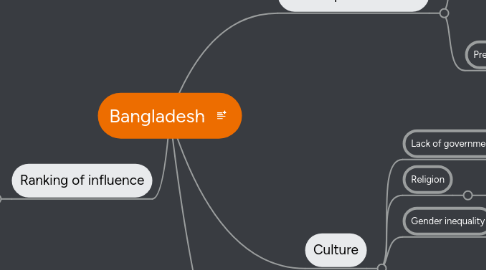
1. Ranking of influence
1.1. 1. Culture
1.1.1. Deeply in grained culture makes it very hard to change it.
1.1.2. Great increase in birth rate of Bangladesh and will greatly increase the birth rates
1.2. 2. Migration
1.2.1. A large amount of people migrate out of the country
1.2.2. Can only be stopped by further development
1.2.3. Decreases the rate of population growth
1.3. 3. Natural phenomenons
1.3.1. Natural phenomenons's impacts can be negated by modem technology.
1.3.1.1. Tropical cyclones killed 140000 people in 1991. However, with advancements in technology, measures like the early warning system and developing shelters have helped decrease the death rate to 2000 in 2007
1.3.1.2. Natural disasters are few and far between and happens triannually
1.3.1.3. Infectious diseases can be curbed with proper health care and sanitation
2. High Birth Rate
3. Migration
3.1. Males leaving the country for work
3.1.1. 1/1000 people migrate from the country
3.1.1.1. While the males are away, women are unable to conceive
3.1.1.1.1. Decreased birth rate
3.1.2. Minimal wage in Bangladesh is 220 dollars per year, while Singapore is 6000 dollars per year.
3.1.3. Lack of jobs in Bangladesh
3.2. Wealthier families migrating
3.2.1. Families migrate due to natural disasters
3.2.1.1. Family chooses to settle down in other country due to more favorable living conditions
3.2.1.1.1. Decreased total population
4. High death rate
5. Cause property damage
5.1. People are left with very little to rebuild their lives
5.1.1. Increased poverty
5.1.1.1. Increased suicide rates
6. Takes lives
7. Natural phenomenons
7.1. Natural disasters
7.1.1. Tropical cyclones
7.1.1.1. Frequent, one every 3 years
7.1.1.2. Cause storm surges
7.1.2. Flooding
7.1.2.1. 6 months of monsoon
7.1.2.1.1. A lot of rainfall, 60-80 inches of rain collected annually
7.2. Presence of diseases
7.2.1. Tuberculosis
7.2.1.1. 425 deaths per 1000 people
7.2.2. Malaria
7.2.2.1. 79 853 death in 2009
7.2.3. Due to poor sanitary conditions and very low expenditure on healthcare
8. Culture
8.1. Lack of government policies
8.1.1. Unrestrained population growth
8.2. Religion
8.2.1. High percentage of the people of Muslims
8.2.1.1. Islam discourages use of contraceptives
8.3. Gender inequality
8.3.1. Males preferred over females
8.3.1.1. Couples may have multiple children until they have a son
8.4. Society
8.4.1. Poor
8.4.1.1. Cannot afford birth control / other contraceptives
8.4.2. Uneducated
8.4.2.1. No family planning
8.4.3. 45% of population involved in primarily agrarian industry
8.4.3.1. Children are seen as an asset as they are 'free labour'.
8.4.3.1.1. High total fertility rate at 2.38
